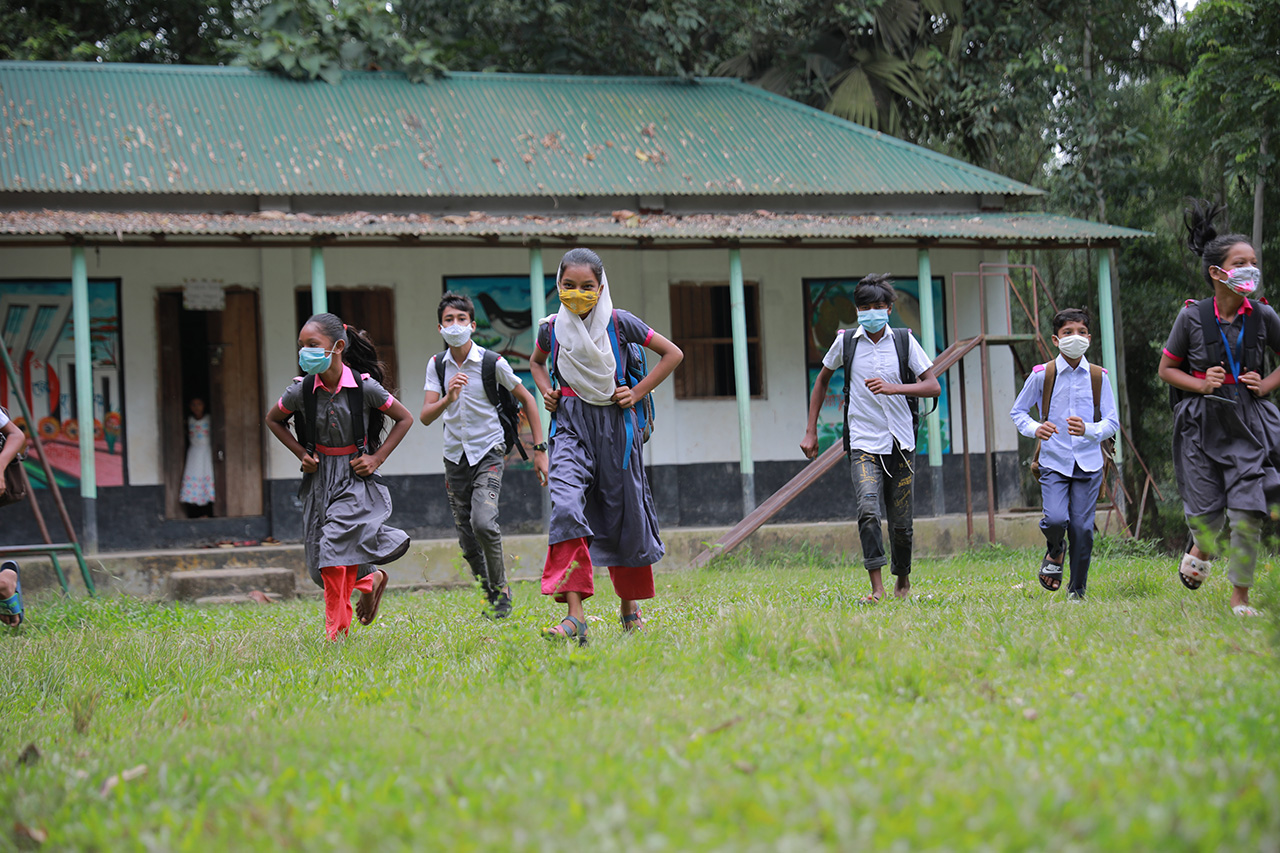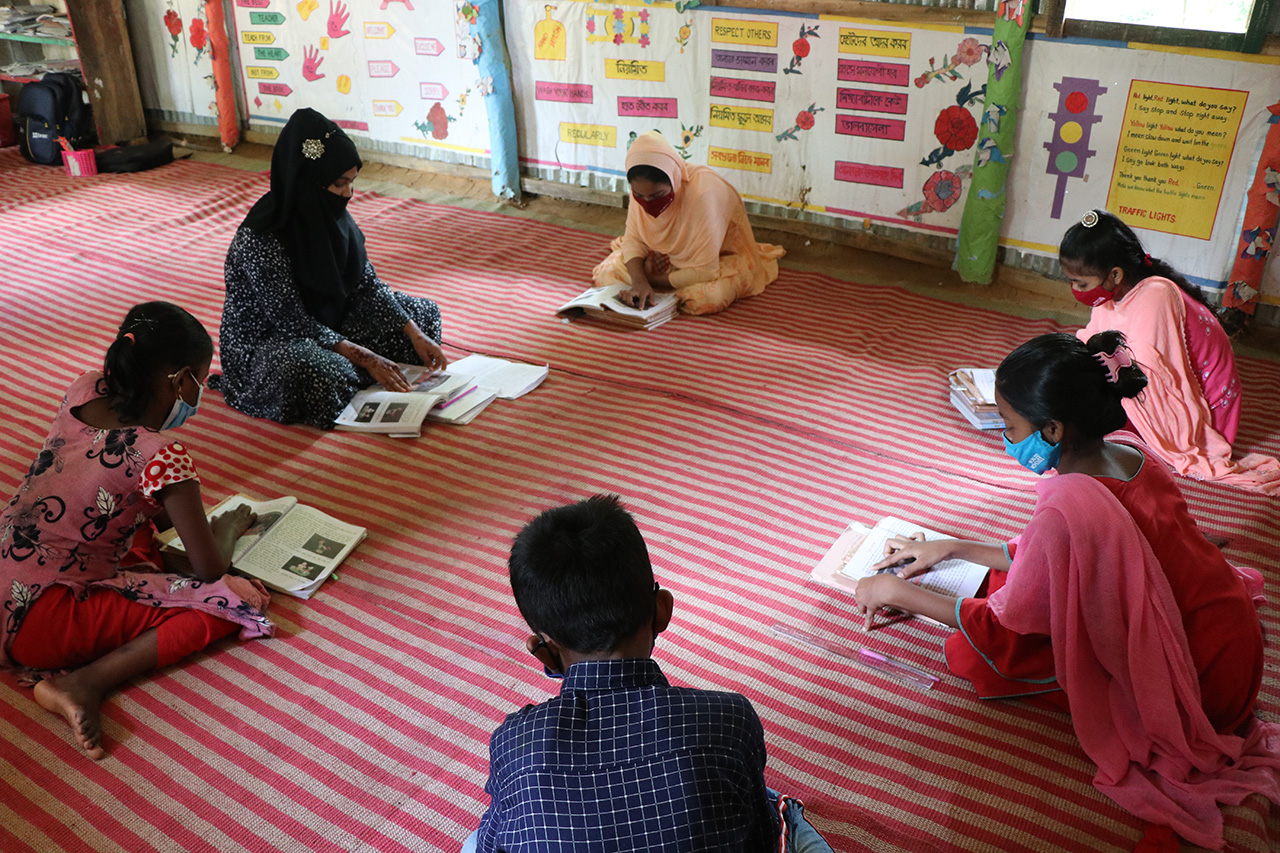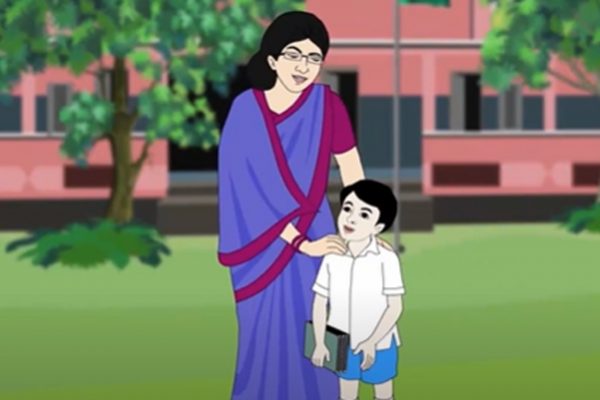Schools in Bangladesh were closed for longer than in any other country. Here’s how BRAC is supporting their reopening
Reading Time: 4 minutes
Schools in Bangladesh reopen this week after the world’s longest shutdown. Prior to the COVID-19 pandemic, BRAC was providing education for almost 750,000 students. During the extended closure, it continued teaching remotely, and ensured that close to 620,000 students graduated from their courses. The remaining students continued learning remotely and, after planning for reopening for months, BRAC opened its doors to 129,000 students this week. Amidst dire predictions of learning loss globally, it is quietly optimistic that its innovative measures to continue learning, combined with a rigorous approach to remediation will get its students back on track.
Initial predictions of learning loss from COVID-19 paint a dire picture. Studies conducted in Karnataka, India, show close to a year of learning loss as a result of the pandemic. Research conducted four years after the 2005 Pakistan earthquake found students affected by three months of school closures were catching up on the equivalent of 1.5 years of schooling. There is evidence for the effectiveness of mitigation measures however, with remediation potentially able to reduce long-term learning loss by half.
The challenge of reopening schools is two-fold: first, maximise the safety of students and teachers amid the ongoing pandemic. Second, understand what learning loss has occurred and help students catch up as quickly as possible.
BRAC’s plans are meticulous not just because they have to work in all of the contexts the organisation works in, from urban slums to remote villages, but also because of the profile of their students – mostly first-time learners from low-income families, and over half of them girls. It is these students that would be most likely to drop out of school even before the pandemic, so the stakes are high for BRAC’s reopening plan to work.

Students washing their hands prior to entering a BRAC school in Bangladesh. Photo credit: Abdullah Al Kafi © BRAC
Staying safe, in a low-cost setting
In BRAC schools, temperatures of students and teachers are checked at the start of each day, either using temporary measures such as digital thermometers (sanitised after each use) or thermal scanners. Designated spaces have been set up for older girl students, to ensure privacy while temperatures are checked. Hand washing stations are set up across schools.
Class sizes have been cut in half to enable social distancing, with students attending in different sessions and no more than 15-20 students in a class at any one time. Designs have been drawn on floors, on benches, at entryways and in any gathering place, to remind everyone to maintain safe distance. Students and teachers will be required to wear masks, and, unless it is raining, they have breaks outside at least once every hour to loosen their masks, so they will be better tolerated for everyone throughout the day. The emphasis with all the protocols is to keep them practical, so they do not become onerous for teachers or students.

Students line up to get their temperatures checked at a BRAC school in Bangladesh. Photo credit: Abdullah Al Kafi © BRAC
Starting with a ‘wellbeing’ week
The first week focuses on welcoming everyone back, mental and physical wellbeing, health, and enjoying being back in school. The key is not only getting students to return, but to want to stay in school after such a long break.
As many students have experienced stress and grief during the pandemic, this will provide dedicated time to catch up, talk and share their experiences with each other. This process is enhanced by the reduced class sizes and the fact that BRAC’s community-based teachers are well positioned to understand each of their students’ personal circumstances.
Read more: Bridge Schools: A second chance at education in Bangladesh

The first day of school in Bangladesh, after 18 long months. Photo credit: Abdullah Al Kafi © BRAC
Going back to school, and staying in school: Assessing where we are at
The longer schools were closed for, the less time BRAC’s teachers realised they would have left to work with students. To get the most of the remaining months in the year, they split and prioritised the curriculum into three categories of competencies: ‘must learn’, ‘should learn’, and ‘good to learn’, with the emphasis being that students cover the ‘must learn’ component at a minimum.
After the initial ‘wellbeing’ week, teachers will conduct an initial formative assessment, focusing on the ‘must learn’ competencies from the last grade that the students attended in-person. The findings of the assessment will be used to identify the overall needs of the cohort, both in and out of the classroom, and to design a remedial intervention for the next 17-20 school days.
Students will learn in a whole group, small groups, peer groups and individually, as per their needs. Teachers will have flexibility to arrange extra times and days for additional learning, if needed.

A teacher reviews a student’s work at a BRAC school in Bangladesh. BRAC’s teachers are from the same communities as their students, which helps them to understand students’ personal circumstances. Photo credit: Abdullah Al Kafi © BRAC
The rest of the school year: Addressing learning losses
A second formative assessment will be conducted after the initial intervention, to understand the educational levels and remaining gaps of individual students. Students will be divided into groups according to the results – good, medium, and needing improvement.
Student learning groups, where stronger students support students who require additional attention, will be expanded outside classrooms, to create more opportunities to learn. Learning will be accelerated for as long as it takes to recover learning loss, using learning from models such as BRAC’s existing Bridge School.

A teacher works with her students in a BRAC school in Bangladesh. Photo credit: Sonali Chakma © BRAC
Will 18 months of phone schooling efforts pay off?
The shift to remote education was challenging for many during the pandemic, but, with only 8.7% of the poorest 20% households in Bangladesh having internet access at home, it was an impossibility for most BRAC students.
To ensure their education continued, teaching went remote – but offline. BRAC conducted classes through feature phones, home assignments, and individual home visits. All of this was supplemented by learning through community radio and television. A rapid appraisal conducted in 2021 shows that these measures supported students to continue learning.
The teachers who led these efforts, like Jharna Begum, are quietly hoping that the impact of their efforts, including walking for hours each day to individually visit students and making weekly calls, will start paying off this week.
Read more: Outside the digital world: How can remote learning be redesigned outside the internet?
BRAC’s network of schools is based on an innovative structure of ‘one-teacher, one-room’ primary schools. Each school is based within a community, with a woman from that community trained as a teacher, who takes a class of 25-30 students through primary school. The schools are complemented by a range of other educational services; pre-primary education, primary education through regular multi-classroom models, secondary education, community-driven libraries and youth services.
BRAC is initially reopening with just its continuing students. BRAC teaches in cohorts and, because it continued teaching through the pandemic, students in the pre-primary and primary levels who had started in 2019 and earlier were able to graduate. No new cohorts were started as school opening was suspended, and with the present academic year soon coming to a close, plans are afoot to start new cohorts early next year.
Watch more: Investing in the next generation: A look at BRAC’s work in education
BRAC started working in education in 1985. Its high quality, affordable, scalable schooling model has made it one of the world’s largest providers of secular, private education. Its holistic approach to lifelong learning, addressing educational needs from early childhood to higher academic levels supported over 15 million students across five countries to graduate to date.
To learn more about BRAC’s approach to investing in the next generation, visit the Education Programme’s website. Find more blogs on what BRAC is doing in education on The Good Feed.
Sarah-Jane Saltmarsh is the head of programme and enterprise communications at BRAC.
Cover photo: Abdullah Al Kafi © BRAC
This write-up received inputs from Safi Rahman Khan, director of BRAC’s education programme in Bangladesh, and Profulla Chandra Barman, programme head BRAC’s education programme in Bangladesh.





